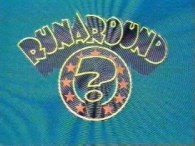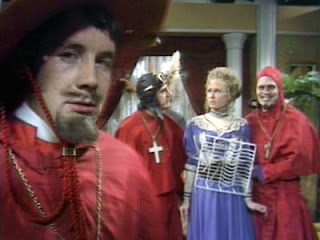I need 12.02 and 12.03 for my collection, can anyone help?
Category: Pictures Page 17 of 46
In the short story A Second Chance, published in 2000AD Prog 245 (Jan 1982), and written by Alan Moore and drawn by Jose Casanovas, the world’s ravaged by war, and a man and woman crawl from the wreckage.
They realise they have to start humanity over again, and the man says:
 “Mavis,” she replies.
“Mavis,” she replies.
All rather amusing, I thought at the time, and I still do now. My expectations were confounded and from thence the humour arose.
However, have a look at this, the last three lines of the post-apocalyptic story The Voice In The Garden, written by Harlan Ellison in 1967, where a man and a woman talk about how they have to restart the human race:
He touched her hand. “I love you, What is your name?”
She flushed slightly. “Eve,” she said. “What’s yours?”
“Bernie,” he said.
I’m genuinely not accusing Mr Moore of nicking this idea, I think it’s probably one of those cases of ‘morphic resonance’ or an idea occurring independently to separate people at separate times, like Tesla and Edison. But I have to say that, given how popular both of these writers are. I’m surprised that I haven’t seen this comparison made before… can I truly be the first person to have spotted it?
Art from 2000AD (c) Copyright Rebellion Inc, 2009. Quote from The Voice In The Garden (c) The Kilimanjaro Corporation 1967, 2009. No infringement is intended, especially as I’m so keen on both the authors’ work.
 Back in 1981, I was a contestant on the children’s TV quiz show Runaround. That’s right, m’dears, at the tender age of 10, I first saw the heady heights of fame… or, at least, was on a networked TV programme.
Back in 1981, I was a contestant on the children’s TV quiz show Runaround. That’s right, m’dears, at the tender age of 10, I first saw the heady heights of fame… or, at least, was on a networked TV programme.
For those of you who don’t remember Runaround, it was essentially a multiple-choice quiz; a question was asked, with the possible answers shown on the wall at the far side of the studio. When the host – Mike ‘Frank Butcher off EastEnders‘ Reid shouted “G-g-g-g-g-g-g-go!”, the contestants would run across the studio and stand in front of the answer they thought was correct. After a few seconds in which you could change your mind, the answer was revealed by a light being shone on the contestants who’d got it right. If you got it wrong, you went into the ‘Sin Bin’, and were out of the game until… er, I forget, but if you got it right, you picked up a coloured ball. The contestant with the most balls at the end of the show was the winner.
Look, I know it sounds basic, but it was a simpler time, all right? We didn’t have crack cocaine and Nintendo iPlaypods, we had to make do with simpler pleasures.
Anyway, this was all filmed at the Southampton studios of now-defunct regional broadcasters Southern Television. To get contestants, they’d come to nearby schools and ask a number of questions – I, strangely enough, got in because I was able to show I had a name beginning with a certain letter of the alphabet, and also had a particular number of pets at home. I didn’t lie about either of these things, but I probably could have. Still, they weren’t looking for Mastermind contestants, I guess, just kids who could read and run, so the entry requirements weren’t too stringent. Eventually, they had enough contestants from the school (four or five, I think), and a date was set.
The day itself was pretty exciting – we were given a bit of a tour of the building (peeping into a room where they were recording something for How), and taken down to the studio where we’d be filming that afternoon. It was a pretty big studio, and so they filled it was coachloads of schoolkids from the surrounding area, including the schools the contestants were drawn from. Then there was a bit of hanging around, and we changed into our specially-personalised Runaround t-shirts and went down for the filming. To say I was excited was an understatement.
At the start of the show, the contestants (the four or five from my school, plus an opposing team from another school, though it was more about trying to win for yourself than any kind of team effort) would run out through a tunnel-shaped opening, and so as the filming began, we were lined up in the tunnel. And this is the point where I make my torrid confession, here on the interweb, to you. Have you ever been in a TV studio, maybe to watch the filming of a show? Well, if you have, you may have seen a lot of the cameras have small spiral-bound pads clipped to them, giving the camera operators a rundown of the places to focus on, etc. In the tunnel before the show started, there was a camera, and on the running order there I could see that for the first question (about how many days there are in July, I think) answer B was circled.
Yes, I’m not proud of it, but I went for B on the first question, and it was indeed correct. I cheated. Not a good thing…
… but there was pretty much instant karma, as I quickly got the next question wrong and spent a lot of time in the Sin Bin, and didn’t come anywhere near winning, so verily cheats did not prosper that day. And rightly so. Who knows how different it might have been if I’d got the first question wrong?
Anyway, whilst I didn’t win the top prize – a portable TV – when it came to the tiebreaker between two boys from the other school, I did have my first insight into the wanton trickery of the televisual medium; the tiebreak question was “What is the fourth month of the year?” and it took them about seven guesses to get it right, but when the show was broadcast, the boy who won appeared to have replied pretty much instantaneously. Oh, television editing, you are misleading.
My prize, for those of you who are interested, was a then-top-of-the-line digital watch; which meant that it told the time, date, and – brace yourself – seconds. About five years later, it was pretty much the sort of watch they’d give you free if you bought £5 worth of petrol, but that’s the march of progress for you.
So, having learned a salutary lesson about cheating, I made my way home, with my watch, Mike Reid’s autograph on the back of one of the question cards (we moved house several months later, and it was lost in the move), and of course my personalised Runaround t-shirt.
Speaking of which, writing about the experience has inspired me to dig out the t-shirt and put it on for old times’ sake. Of course, I was a lot smaller then, but let’s see if I can still get into it…
…Oh.
Looks like I’ve grown a bit in the last 28 years, then.
 As the week draws to its end, I just wanted to share with you, my lovely readers, one important lesson which I’ve learned in the last few days:
As the week draws to its end, I just wanted to share with you, my lovely readers, one important lesson which I’ve learned in the last few days:
Unless you actually are a sculptor, or have a hand as steady as a professional stonemason, do not attempt to remove ice from a freezer compartment with a screwdriver and hammer.
Yes, I am an idiot. Still, the new fridge-freezer looks good in the kitchen.
 So, I didn’t make it to the next round of the CBBC Competition. Ah well.
So, I didn’t make it to the next round of the CBBC Competition. Ah well.
I did, however, get a friendly e-mail from the BBC Writersroom, saying that my script had made it through to the second reading stage, and encouraging me to send stuff to them in future, which was nice.
And, of course, it was good to find out either way, on the appointed day. Well played, BBC, I say.
But enough of me; you’re a bunch of talented sods out there, surely at least one of you has been asked to go along to the masterclass? C’mon, share the good news, that’s what the Comment function is for…
 I referred to the Monty Python Spanish Inquisition Sketch the other day (in this post), and that led me to think about its appearance in the film Sliding Doors. Hey, that’s how my mind works.
I referred to the Monty Python Spanish Inquisition Sketch the other day (in this post), and that led me to think about its appearance in the film Sliding Doors. Hey, that’s how my mind works.
For those of you who haven’t seen this film (and I’ve only seen it once, at the time of its cinema release), John Hannah recites lines from the Spanish Inquisition sketch to a table of hysterically impressed friends, including Gwyneth Paltrow – in fact, his Python performance kind of forms part of his wooing of her character in the film. The people around the table are laughing a lot at this bit in the film, including women, which didn’t ring true for me, as I was the kind of spotty indoorsy teenager who’d learn Monty Python sketches off by heart, and as much as women like a laugh and like comedy, very few of them are particularly keen to hear you recite other people’s comedy material. Especially a sketch as reliant on visual aspects and incidental music as that one.
Anyway, as an aspect of the film in which we’re supposed to think Hannah’s character’s funny or likeable, it didn’t work for me. In a similar way, I once found myself watching Showgirls to see if it was as bad as it was said to be (it was), and about twenty minutes in (I think – it was just before the first ad break, and I switched it off then) there was a big song and dance number. The main character, played by Elizabeth Berkeley, watches this show on stage, and is utterly captivated by it. I, on the other hand, thought it was a pretty risible sequence featuring semi-naked people cavorting amidst model volcanoes.
Hmm, those last three paragraphs make it sound as if I’m just having a go at other people to make my point (and I do have one), so let me share a similar confession about my own writing; some years ago, I wrote a novel (unpublished, and with hindsight that’s probably fair) called Fall From Grace. It was essentially a re-telling of the fall of Lucifer, set within a modern-day Evangelical Broadcasting Network – members of staff rebel against the existing regime, get kicked out, seek to take revenge, that sort of thing.
Reader: These religious broadcasts don’t strike me as that awe-inspiring.
Me: Well, they are. Trust me.
Reader: They wouldn’t convert me.
Me: Well, the people in the book are quite taken with them.
Reader: I don’t know why.
Me: Look, they’re really impressed. Take my word for it.
Reader: I suppose I have to, for the story to make sense.
Me: Yes, you do.
Reader: Hmph.
Otherwise, you end up just having to take other characters’ word for it; John Hannah’s character is funny, the show in Showgirls really is impressive, and in my personal example, millions of people do tune in every week to watch a religious TV show… and if you don’t believe what the story wants you to believe, or feel the reaction that you’re apparently expected to feel, you’ll be jerked right out of the experience of the story, and that’s never a good thing.
Looking at how this should be done, I watched the first episode of The West Wing again yesterday, and – possible spoilers ahoy – we don’t get to meet the President himself until very near the end of the episode. Instead of the viewer being told for the best part of an hour that he’s quick-witted, supportive of his staff, and articulate, we’re shown it – President Bartlet demonstrates this in a couple of minutes, and at the end of the scene (indeed the episode) you can see why his staff are so loyal to him. That, as Mr Punch would say, is the way to do it.
The Roman Emperor and philosopher Marcus Aurelius once said “Waste no more time arguing what a good man should be. Be one”, and I think the same applies to aspects of plot or character as detailed above. Is a character meant to be funny? Show them being funny, not other people telling them they’re funny. Is something in a story meant to be amazing or startling, and send people’s lives in a new direction? Then the story needs to show it being amazing or startling.
As is so often the case, I won’t pretend that I’m making a devastating insight about a requirement of writing here; however, I was quite pleased when all the above churned around inside my head, and I finally realised that all of the examples which sprang to my mind all point to one fundamental principle of writing: Show, Don’t Tell.
… which seven-volume fantasy series which began with a fairly slim first volume got more and more lengthy as the end drew nigh: Jo Rowling’s Harry Potter or Stephen King’s Dark Tower?
Let’s find out! Potter’s in Blue, the Tower is Purple…
 So – perhaps appropriately enough – the Tower has the highest numbers.
So – perhaps appropriately enough – the Tower has the highest numbers.
Here’s a thought: how different would the current state of Bloomsbury publishers be if the Potter books had each been 324 pages long, and the series had run to ten books ?
I know that books, unlike many media, can be as long as they need to be to get the story told, but I’ll wager that somewhere, a publishers’ accountant has asked exactly the same question, though they probably followed it with a sigh, and then returned to crunching numbers.
 (Found in a number of places on the internet.)
(Found in a number of places on the internet.)
Well, it makes me laugh.
And that’s why I shared it – because if there’s one thing this blog is all about, it’s spreading laughter and joy and love and peace and tea and biscuits. Oh, and it’s about writing. But that’s still one thing, if we use the Inquisitional numbering system.
Speaking of matters writerly, it seems that the CBBC Competition had over 700 entries. Crikey.
Still, I’m keeping my fingers crossed… though if I do get through, I won’t hurry to claim it’s a case of the cream rising to the top – after all, the scum also rises, as Hemingway nearly put it.
Still, we’ll see how things go, and of course if I get invited to the next stage (a workshop), I’ll be sure to talk about it in the usual self-hyping fashion here on the blog. Because if there’s one thing this blog is about, it’s… ah, you guessed it.
 Like many people with a letterbox, I’ve become accustomed to coming home to find myself dazzled by a shining sea of glossy junk mail – pizza menus, flyers for estate agents and repair firms, and party political newsletters and the like.
Like many people with a letterbox, I’ve become accustomed to coming home to find myself dazzled by a shining sea of glossy junk mail – pizza menus, flyers for estate agents and repair firms, and party political newsletters and the like.
I’ve become kind of jaded to it really, so my immediate reaction is to ignore the stuff – the exact opposite of the hoped-for result, I’m sure – and it takes something quite startling to make me actually pay attention to unsolicited mail.
Which is why the flyer which you can see here (scanned in from the original, hence the scuffmark across the middle from my shoe) caught my attention when it arrived. I’m well aware that there’s a market for this service, but … well, I’d kind of hope that people would do a bit of research beyond waiting for a leaflet on the subject to come through the door.









